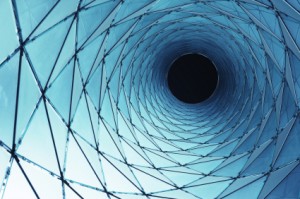We were instructed to begin our posts with our question. Singular. But my project is the culmination of many questions, some of which drew me to Making Meaning Matter to begin with. How can we each discover our own value out of seeing our thoughts materialize before our eyes? Is it possible to not just imagine but witness the transformation of our ego-consumer-driven age to one that learns from, engages with and contributes to the life of and on this planet? How can we use language, our language, to birth our ideas, the delicate, vulnerable, innermost beauty of our being, when we experience daily the limits and inconsistencies our language imposes on us? How can we use 3D printing to get in touch with what it means to be a human, on this planet, in this time?
The question for this project is: Can a 3D printed object be responsive to its environment and to the dynamic energies of the people and processes that interact with it?
Yes, I want to create something that is alive, responsive, intuitive, and vulnerable. I want to create an object that will interact with its environment. The 3D object will either itself be made from magnetic materials, or will contain conductive filament such that it can interact with a magnetic force to create a magnetic field in and around the 3D object. Whether I can create a magnetic 3D object or a 3D object with conductive filament will determine the next phase of my project.
If the 3D object is made with a conductive filament then I will introduce a ferrofluid which will demonstrate how the 3D object is interfacing with the magnet and its environment by following the flux lines of the 3D object (Ferrofluid). The particular shape of the 3d object has yet to be determined, and I will experiment with various shapes that mimic the fundamental shapes found in many patterns throughout the world; torus, vector equilibrium (cuboctahedron), 64 tetrahedron grid, flower of life, and others.
If the 3D object is itself magnetic then I will print a number of smaller 3D objects and experiment with a series of smaller magnets. In this case, I will 3D print a number of small flying birds, and attempt to mimic a murmuration of starlings (Keim), what I would consider a 4D version of Indra’s Net.
The shapes I spoke of earlier have been found by many scientists, inventors, innovators, and philosophers to be the basic building blocks of the world we live in today. The structural shape of the vector equilibrium and the torus shape of the magnetic energy field that surrounds every living thing at every scale in the universe, have shown up throughout written history and across nearly every major culture spanning the earth. These shapes are considered the code for a sustainable and ever-evolving cosmology that, when adopted, could mean the end of the myriad concerns enveloping our consumer driven world today (Thrive).
Buckminster Fuller said “The VE represents the ultimate and perfect condition wherein the movement of energy comes to a state of absolute equilibrium, and therefore absolute stillness and nothingness” (Cosmometry). When the eight tetrahedra of the vector equilibrium are expanded out to the next scale, the 64 tetrahedra grid is built. When spheres are drawn around each of the individual tetrahedra, the tetrahedra removed, and the image of the spheres turned two dimensional, the flower of life appears in the overlapping circles. The flower of life has been found in the ancient Temple of Osiris in Egypt as well as The Forbidden City in China, both of which were built centuries ago (Thrive). Even Leonardo da Vinci contemplated on the flower of life in his drawings and used the torus energy shape in some of his inventions (The Secret to How the Universe Works).
You say, so what? What difference will it make to spend a quarter exploring this idea and its manifestations? It will make absolutely no difference if what happens during the unfolding of this idea is not documented, reflected upon and critical discoveries made known. This question could better be answered by Lambros Malafouris’ argument “that by knowing what things are, and how they were made what they are, [we] gain an understanding about what minds are and how they become what they are – and vice versa (Malafouris, 9).” I hope his argument coupled with my curiosity will give me a clear insight into my overarching question: what does it mean to be human?
Works Cited
Cosmometry: Exploring the Fractal Holographic Nature of the Cosmos. Retrieved October 20, 2014, from http://www.cosmometry.net/overview-of-cosmometry
Ferrofluid on the track of a Meatgrinder. (2008). Retrieved from https://www.youtube.com/watch?v=OE2pB1pyZN0&feature=youtube_gdata_player
Keim, B. (2011, November 8). The Startling Science of a Starling Murmuration. Retrieved October 20, 2014, from http://www.wired.com/2011/11/starling-flock/
Malafouris, L. (2013). How things shape the mind: a theory of material engagement. Cambridge, Massachusetts: MIT Press.
THRIVE: What On Earth Will It Take? (2012). Retrieved from https://www.youtube.com/watch?v=lEV5AFFcZ-s&feature=youtube_gdata_player
The Secret To How The Universe Works Lies Within This Geometrical Pattern. What Is The Flower of Life? (n.d.). Retrieved October 20, 2014, from http://www.collective-evolution.com/2013/12/10/the-secret-to-how-the-universe-works-lies-within-this-geometrical-pattern-what-is-the-flower-of-life/


